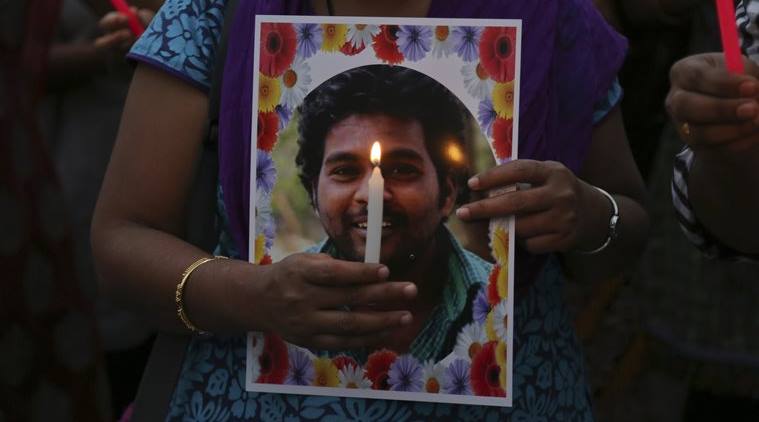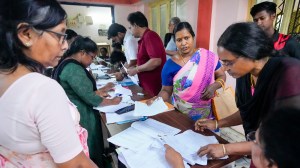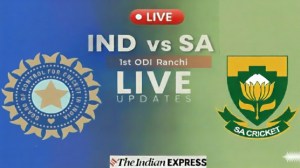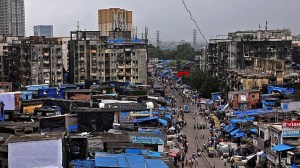Rohith Vemula: Of the Political and the Apolitical
It also seems intended to absolve herself of her/ her ministry’s involvement in the issue since Rohith and four other students were suspended in August 2015.
 Rohith Vemula
Rohith Vemula
MHRD minister Smriti Irani’s constant reference to Rohith Vemula as a ‘child’ in her Loksabha speech of 24th February 2016 points to the gendered and perceived infantile nature of caste. It also seems intended to absolve herself of her/ her ministry’s involvement in the issue since Rohith and four other students were suspended in August 2015.
More importantly, it brings forth the notion of a privileged ideal mother. Especially because the actual mother’s grief, disprivilege, language and politics are far removed from that of Irani’s, it is important to see how a child and mother are made apolitical. Radhika Vemula is not the ideal – a Dalit child taken into a backward caste family, married and then separated, single woman raising three children, no public display of religious/Hindu practice, strong in times of grief, political in her son’s death – these do not constitute features of ideal motherhood. It is impossible for Rohith’s mother to claim her son for various reasons.
Consider the institutionalised casteist patriarchy that has led to police investigating into his caste; that has made sections claim that he belongs to Vaddera community – his father’s caste; the necessity that demanded her to come out to declare her caste; the claims that this is not a Dalit vs non-Dalit issue implying that Rohith does not belong to his mother and her caste. There is then an effective delegitimization of the woman who gave birth to him and who brought him up fighting the entrenched prejudices against a single woman in the society. One can only imagine the life she led as a daily wage worker and tailor compounded with the fact of being a Dalit and the resulting humiliation from her then husband and society, now well recorded in Sudipto Mondal’s “Rohith Vemula: An Unfinished Portrait”.
That Government Orders of Andhra Pradesh, 1976 (G.O.Ms.No. 371–Extension of the benefits available for Schedule castes, Schedule Tribes and Backward classes to the children of inter-caste marriages) and Supreme Court judgement of January 2012 are very clear on that a child can indeed belong to and claim the mother’s caste does not figure in the discourse of the current governing institutions point to how we are still governed by patriarchal norms dictated by caste practices.
The contradiction here is noteworthy – Rohith being fatherless for all practical purposes ends up not belonging to his mother in his death. What has ensued from all this is Rohith’s mother’s loss of claim over her dead son whom she struggled to bring up along with her other two children. Now that Radhika Vemula is pushed outside the frame of ideal mother, it has become very convenient for Rohith to be “Mother India’s son” in PM Modi’s words or the innocent ‘child’ in minister Smriti Irani’s words.
Another interesting binary is also cast between the political and the apolitical in the debate between BSP leader Mayawati and minister Smriti Irani. While Mayawati forced the Rajyasabha to debate on Rohith thus reasserting his political legacy, Irani’s response in Rajyasabha and Loksabha constantly referred to Rohith as a child who was used as a political weapon. Although it might appear as sudden, Rohith’s transformation into a child is a very calculated move. While Rohith lived, his body was only political and in his death he becomes a child for the same people who deplored his politics.
From BJP Minister Mr. Bandaru Dattatreya’s letter to MHRD that was extraordinarily aggressive and had unfounded allegations of university students being casteist, anti-national to the five rejoinders from MHRD to the University of Hyderabad between 03-09-2015 and 19-11- 2015 with the subject line “anti-national activities in Hyderabad Central University Campus”, there was nothing to suggest the child in Rohith and other students. It is only when Rohith and his Ambedkarite politics has captured the imagination of students across the country that Rohith gets transformed into the apolitical, ahistorical child.
This constant reference to him as a child is nothing but a patronizing attempt to dehumanize his reality. It is also deeply disrespectful to Rohith’s mother whose child he actually is – because she knows how ironic Irani’s appropriation of him is, considering her culpability in his death. If Mayawati laid claim to the political Dalit, Irani’s response attempts to overturn this by claiming the ‘child’ who is now being used as a political tool.
In hindutva’s understanding of the ideal mother, Mayawati of course will not figure. Her Dalitness, her single status, her unconventional gender mannerisms, her unquestionable leadership are not something palatable to patrons of ideal family. (Despite their ironic invocation of Durga, the not-so-ideal woman figure in the pantheon of Hindu goddesses). If hindutva ‘allows’ Mayawati anything at all, it is only the political child, whose politics is abominable to hindutva. The mother figure whose rights/emotions are unquestionable can only emerge from the likes of Irani, not Radhika Vemula, not Mayawati.
Adding to this debate between the political and apolitical is the letter Rohith wrote just before his death which is touted as philosophical and heart wrenching. How do we read the suicide note? Especially given the Ambedkarite politics he was so assertively part of ? How do we read his sentence “my birth is my fatal accident”, given the choice he chose his mother’s Dalit caste and chose to live as a Dalit? As Manash Bhattacharjee so evocatively wrote, Rohith’s dream of “from Shadows to the Stars” can only be read as the Dalit’s experience, “whose shadow pollutes the caste Hindu, one who is ascribed a body that embodies the shadow of pollution, feels like a shadow aspiring for the stars. From measure to immeasurability.”
Perhaps we need to ask the question as to why and how despite a whole life of struggle, what’s left are unrealised dreams and a reduction to “an identity, a number, a thing”. Is it not unfortunate that Ms Irani could so easily claim for herself a minority status in her Loksabha speech without pausing to introspect as to how her status could by any stretch of imagination be equated with the state of stigma, disprivilege and dispossession that Dalit and other Minority students battle on a daily basis? The concerted effort to read the letter in an a-political plane furthers the argument that wishes to subdue Dalit politics within individualist, humanist realms.
If dominant politics is naturalised and accepted among the mainstream, we need to ask why only when anti-caste politics asserts itself that campuses become threateningly political?
I wish to thank many students, friends and colleagues for their inputs.



- 01
- 02
- 03
- 04
- 05




























